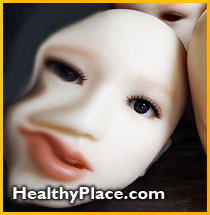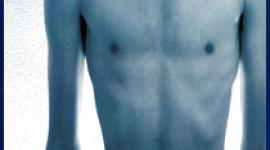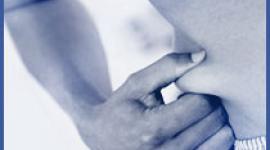Body Dysmorphic Disorder
 Body Dysmorphic Disorder (BDD) is a mental disorder defined as a preoccupation with a perceived defect in one's appearance. If a slight defect is present, which others hardly notice, then the concern is regarded as markedly excessive. In order to receive the diagnosis, the preoccupation must cause significant distress or impairment in one's occupational or social functioning.
Body Dysmorphic Disorder (BDD) is a mental disorder defined as a preoccupation with a perceived defect in one's appearance. If a slight defect is present, which others hardly notice, then the concern is regarded as markedly excessive. In order to receive the diagnosis, the preoccupation must cause significant distress or impairment in one's occupational or social functioning.
An Italian doctor, Morselli, first coined the term dysmorphophobia in 1886 from "dysmorph" a Greek word meaning misshapen. It was subsequently renamed Body Dysmorphic Disorder by the American psychiatric classification. Freud described a patient whom he called the "Wolf man" who had classical symptoms of BDD. The patient believed that his nose was so ugly that he avoided all public life and work. The media sometimes refer to BDD as "Imagined Ugliness Syndrome". This probably isn't particularly helpful, as the ugliness is very real to the individual concerned.
The degree of handicap varies so that some people will acknowledge that they may be blowing things out of all proportion. Others are so firmly convinced about their defect that they are regarded as having a delusion. Whatever the degree of insight into their condition, sufferers often realize that others think their appearance to be "normal" and have been told so many times. They usually distort these comments to fit in with their views (for example, "They only say I'm normal to be nice to me" or "They say it to stop me being upset"). Alternatively they may firmly remember one critical comment about their appearance and dismiss 100 other comments that are neutral or complimentary.
What are the most common complaints in BDD?
Most sufferers are preoccupied with some aspect of their face and often focus on several body parts. The most common complaints concern the face, namely the nose, the hair, the skin, the eyes, the chin, or the lips. Typical concerns are perceived or slight flaws on the face or head, such as hair thinning, acne, wrinkles, scars, vascular markings, paleness or redness of the complexion or excessive hair. Sufferers may be concerned about a lack of symmetry, or feel that something is too big or swollen or too small, or that it is out of proportion to the rest of the body. Any part of the body may however be involved in BDD including the breasts, genitals, buttocks, tummy, hands, feet, legs, hips, overall body size, body build or muscle bulk. Although the complaint is sometimes specific "My nose is too red and crooked"; it may also be very vague or just refer to ugliness.
When does a concern with one's appearance become BDD?
Many people are concerned to a greater or lesser degree with some aspect of their appearance but to obtain a diagnosis of BDD, the preoccupation must cause significant distress or handicap in one's social, school or occupational life. Most sufferers are extremely distressed by their condition. The preoccupation is difficult to control and they spend several hours a day thinking about it. They often avoid a range of social and public situations in order to prevent themselves feeling uncomfortable. Alternatively they may enter such situations but remain very anxious and self-conscious. They may monitor and camouflage themselves excessively to hide their perceived defect by using heavy make-up, brushing their hair in a particular way, growing a beard, changing their posture, or wearing particular clothes or for example a hat. Sufferers feel compelled to repeat certain time consuming rituals such as:
- Checking their appearance either directly or in a reflective surface (for example mirrors, CDs, shop windows)
- Excessive grooming, by removing or cutting hair or combing
- Picking their skin to make it smooth
- Comparing themselves against models in magazines or television
- Dieting and excessive exercise or weight lifting
Such behaviors usually make the preoccupation worse and exacerbate depression and self-disgust. This can often lead to periods of avoidance such as covering mirrors or removing them altogether.
How common is BDD?
BDD is a hidden disorder and its incidence is unknown. The studies that have been done so far have been either too small or unreliable. The best estimate might be 1% of the population. It may be more common in women than in men in the community although clinic samples tend to have an equal proportion of men and women.
When does BDD begin?
BDD usually begins in adolescence - a time when people are generally most sensitive about their appearance. However many sufferers leave it for years before seeking help. When they do seek help through mental health professionals, they often present with other symptoms such as depression or social phobia and do not reveal their real concerns.
How disabling is BDD?
It varies from a bit to a lot. Many sufferers are single or divorced, which suggests that they find it difficult to form relationships. Some are housebound or unable to go to school. It can make regular employment or family life impossible. Those who are in regular employment or who have family responsibilities would almost certainly find life more productive and satisfying if they did not have the symptoms. The partners or families of sufferers of BDD may also become involved and suffer.
What causes BDD?
There has been very little research into BDD. In general terms, there are two different levels of explanation - one biological and the other psychological, both of which may be correct. A biological explanation would emphasize that an individual has a genetic predisposition to a mental disorder, which may make him or her more likely to develop BDD. Certain stresses or life events especially during adolescence may precipitate the onset. Sometimes use of drugs such as ecstasy may be associated with the onset. Once the disorder has developed, there may be a chemical imbalance of serotonin or other chemicals in the brain.
A psychological explanation would emphasize a person's low self-esteem and the way they judge themselves almost exclusively by their appearance. They may demand perfection and an impossible ideal. By paying excessive attention to their appearance, they develop a heightened perception of it and become increasingly accurate about every imperfection or slight abnormality. In the end there is a big disparity between what they believe they should ideally look like and how they see themselves. What a sufferer therefore "sees" in a mirror is what they construct in their head and this depends upon a number of factors such as mood and their expectations. The way a sufferer avoids certain situations or uses certain safety behaviors perpetuates the fear of others rating them and maintains their excessive attention on themselves.
What are the other symptoms of BDD?
Sufferers are usually demoralized and many are clinically depressed. There are many similarities and overlaps between BDD and Obsessive Compulsive Disorder (OCD) such as intrusive thoughts, frequent checking and reassurance seeking. The main difference is that BDD patients have less insight into the senselessness of their thoughts than OCD sufferers do. Many BDD patients have also suffered from OCD at some time in their life. Sometimes the diagnosis of BDD is confused with anorexia nervosa. However in anorexia, individuals are more preoccupied by self-control of weight and shape. Occasionally, an individual may have an additional diagnosis of BDD when she is also preoccupied by the appearance of her face.
Other conditions that frequently exist in combination with BDD or are confused with BDD include:
- Apotemnophilia. This is desire to have a disabled identity in which sufferers with healthy limbs request one or two limb amputations. Some individuals are driven to DIY amputation such as putting their limb on a railway line. Very little is known about this bizarre and rare condition. However there are significant differences between apotemnophilia and BDD as cosmetic surgery is rarely successful in BDD.
- Social phobia. This is a fear of being rated negatively by others leading to avoidance of social situations or marked anxiety. This usually stems from the sufferer's belief that he or she is revealing themselves to be inadequate or inept. If the concern is only about appearance then the BDD is the main diagnosis and the social phobia is secondary.
- Skin-picking and trichotillomania This consists of an urge to pluck one's hair or eyebrows repeatedly). If the skin-picking or hair-plucking is out of concern with one's appearance then BDD is the main diagnosis.
- Obsessive Compulsive Disorder (OCD). Obsessions are recurrent intrusive thoughts or urges, which the sufferer usually recognises to be senseless. Compulsions are acts, which have to be repeated until a sufferer feels comfortable or "sure". A separate diagnosis of OCD should only be made if the obsessions and compulsions are not restricted to concerns about appearance.
- Hypochondriasis. This is a doubt or conviction of suffering from a serious illness which leads a person to avoid certain situations and to check their body repeatedly. The International Classification of Diseases (ICD-10) classifies BDD as part of hypochondriasis whereas the American classification regards it as a separate disorder.
Are people with BDD vain or narcissistic?
No. BDD sufferers may be spending hours in front of a mirror but believes themselves to be hideous or ugly. They are often aware of the senselessness of their behavior, but none the less have difficulty controlling it. They tend to be very secretive and reluctant to seek help because they are afraid that others will think them vain.
How is the illness likely to progress?
Many sufferers have repeatedly sought treatment with dermatologists or cosmetic surgeons with little satisfaction before finally accepting psychiatric or psychological treatment. Treatment can improve the outcome of the illness for most sufferers. Others may function reasonably well for a time and then relapse. Others may remain chronically ill. BDD is dangerous and there is a high rate of suicide.
What treatments are available?
As yet, there have been no controlled trials to compare different types of treatment to determine which is the best. There have been a number of case reports or small trials that have shown benefit with two types of treatment, namely cognitive behavior therapy and anti-obsessional medication. There is no evidence that psychodynamic or psychoanalytical therapy is of any benefit in BDD, in which a lot of time is spent looking for unconscious conflicts that stem from childhood.
Cognitive Behavior therapy
Cognitive Behavior Therapy (CBT) is based on a structured program of self-help so that a person learns to change the way he thinks and acts. A person's attitude to his appearance is crucial as we can all think of people who have a defect in their appearance such as a port wine stain on their face and yet are well adjusted because they believe that their appearance is just one aspect of themselves. It is therefore crucial to learn during therapy alternative ways of thinking about one's appearance. BDD sufferers need to learn to confront their fears without camouflage (a process called "exposure") and to stop all "safety behaviors" such as excessive camouflage or avoiding showing one's profile. This means repeatedly learning to tolerate the resulting discomfort. Facing up to the fear becomes easier and easier and the anxiety gradually subsides. Sufferers begin by confronting simple situations and then gradually work up to more difficult ones.
Cognitive Behavior Therapy has not yet been compared to other forms of psychotherapy or medication so we don't yet know which is the most effective treatment. However there is definitely no harm combining CBT with medication and this may be the best option.
Cognitive behavior therapists come from a variety of professional backgrounds but are usually psychologists, nurses or psychiatrists.
next: Body Image Problems Stop Hating Your Body
~ eating disorders library
~ all articles on eating disorders
APA Reference
Gluck, S.
(2009, January 15). Body Dysmorphic Disorder, HealthyPlace. Retrieved
on 2025, December 30 from https://www.healthyplace.com/eating-disorders/articles/body-dysmorphic-disorder



